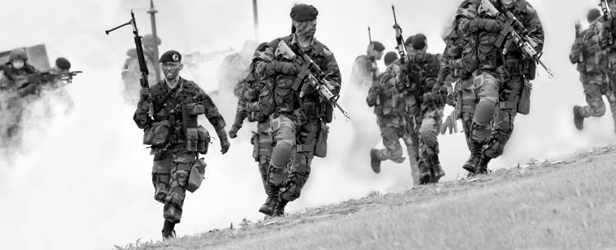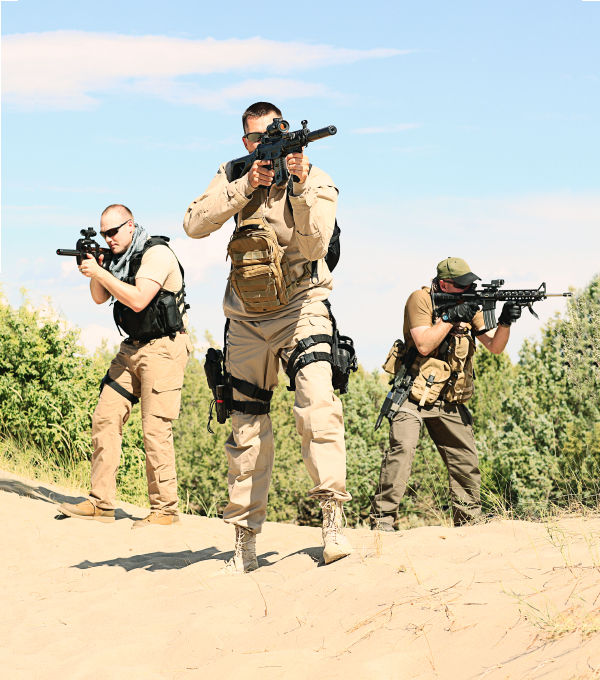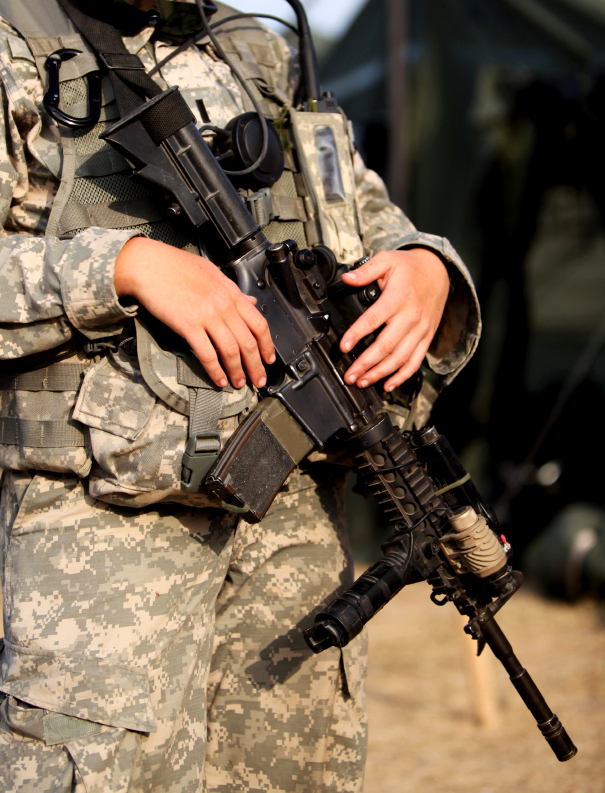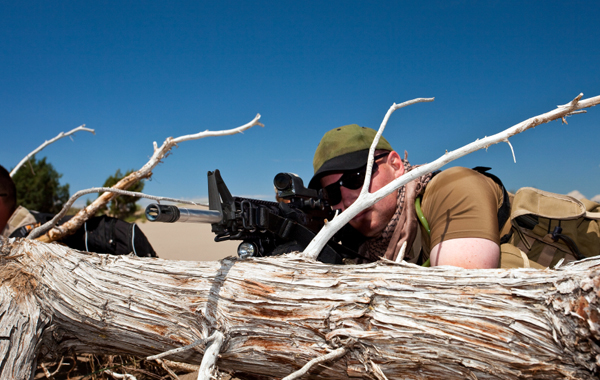
Due to OPSEC (Operational Security) the location and names have been redacted from the following account SpecOps (Special Operations) combat story:
Several months ago my team and I were on a search and observation mission along a foreign border. We were strictly ordered to observe only, using the night as our ally. There were eight of us on the SOT team collecting intel and data on drug trafficking. This was a routine assignment, similar to missions we had done several times before. There was no expectation that we would run into any resistance, and planned to just document numbers and take pictures of vehicles and individual faces.
The weather had been giving us hell with straight downpour for days and gave no signs of stopping. My team’s observation point was positioned 50 meters outside of the camp we were collecting intel on. We had been hidden there for three days and counting, with zero issues. We had no idea what was about to happen on the fifth day of our OP or that it would turn out to be legendary.
We moved around, changing locations and trying to keep the wind blowing toward us. But as with any OP, nothing worked out the way we wanted it to. The wind was shifting and now blowing at our backs. We had to move, and move fast! We had to make a quick tactical decision to move before sundown. Which we would later unfortunately find out to be the worst decision our commander had ever made.
As we tactfully packed up our gear to move position, almost instantly we encountered very heavy gunfire. The kind you only ever see in the movies. Being the trained team we were, we instantly started to engage and exchange gunfire without mercy and stood our ground for as long as we could. After a time I can not even recount for, we were running out of ammo and fear started to take over.
We started making our way backward with overlapping fire and grenades, but that only slowed our enemy down. An enemy bullet grazed my left arm, and I took shrapnel in both of my shins. A friend and teammate of mine took an AK round in the throat and was almost instantly Killed in Action (KIA). Another teammate took a .50cal round through his back, which instantly took his life, making another KIA. As we continued to overlap and return fire, another teammate took several rounds of AK fire through his abdominal section resulting in a third KIA.
I picked up my friend with a neck wound and carried him as far and fast as I could. With the adrenaline from our intense firefight, I thought I was sprinting, but it what was only a fast walk. While carrying my buddy out of the hell we were caught up in, he died on my back. But I was not going to leave my friend there.
No matter what we did, we could not outrun them. The next best option we had was to hide, so we took cover, and we used the rain, plants, and darkness to avoid being detected. We finally made it to our extraction point, but with three casualties that could have been avoided. I will never forget that day.
The above story was not mine. It is a personal account from a friend who will go unnamed. I wanted to share this story to make readers aware of one of the typical combat situations that the public rarely hears. Also, to bring up how being prepared the best you can for any given combat scenario will help you operate better and make it out alive of any situation.
My personal journey has gone from enlisting into the Army, completing Infantry school, Airborne School and then ending up at Ft. Bragg in the 82nd Airborne. After some personal issues that I won't get into, I had left, but was unable to re-enlist due to drawdowns in size. I followed up with two years working as a private contractor in the Middle East. During that time, I focused on my training, experimenting and honing my crafts as I knew I was always going to come back into the coaching world. From all of this experience, trial-and-error as a coach before, during, and after the military, along with seeing the poor understanding and programming within the military training its elite soldiers, I developed my training philosophy (which I refer to as TacWODS).
What does the training entail?
TacWODS training motto is simply “Train Smarter, Operate Harder.” While it is easy for anyone to train hard, push yourself, bring on the suck, and crush you, it takes something else to do it in a tactical and purposeful manner to make you a better operator in the field. This is our goal with TacWODS and what we have designed.
The program we are currently using with active duty military from various branches and areas including Special Operations among decorated combat-hardened vets. This is in no means to brag, but we believe in what we do, and will do everything we can to make sure the men and women of our armed forces (along with law enforcement and firefighters) make it home to their families at the end of the day.
So, what exactly goes into a tactical training program? The three major components of a proper tactical training program that most people miss are below.
1) Max/Sub Maximal strength training.
This is something a lot of programs are missing. While many programs incorporate some strength training, they stick to a very limited training percentage (typically around 40-60%). We know that strength is important—not just strength endurance but also maximal strength—and put a big focus to increase both. We constantly train anywhere from as little as 40% to as high as 95% in our training cycles. This way we have found really brings the most benefit to real world tactical operations. Think of it this way: the stronger you are, the less energy it will take you to carry a lighter load, just as in the real life account above, in which it was crucial to be able to carry equipment and a buddy on your back. When you are used to training with two times your bodyweight or more, having an extra 50-100 or more pounds on you will take less energy to handle, making you operate better at the current operational situation.
I know this might shock some people and we will get haters, but we do not include the Olympic lifts into our programs. We stick with the basics of the squat, bench, deadlift, and press. This is not to say that Olympic lifts are bad, I have just found a much faster, better carryover to real world tactical application and brute strength with these four lifts. The way I explain it is that, while a snatch is not a bad lift, it is pretty amazing watching the technical precision of an elite level lifter snatch such a massive weight overhead. But, you are going to have a much better real combat carryover from building up a solid squat and a press than worrying about how awesome your snatch is.
2) Conditioning
Combinine proper conditioning with your strength training. It is easy to have someone do a bunch of busy shit, run for miles, breathe heavy, and sweat. You want to make sure what you are doing has a carryover to your actual tactical application while adding to your strength program (or vise versa), not taking away from one another. We do things such as doing a loaded carry with varying objects, picking up odd objects (even a buddy) and carrying for distance. Another way we like to do this at times is to work on absolute strength then bring in strength endurance doing something such as a ruck run. All of the previous and more have a real world application carryover making sure you are at peak levels being prepared for the unplanned.
If one has to suffer over the other that is the first sign of a poorly-designed program. The biggest thing that people miss in this is not actually having to run for long distances. While we still include forced ruck runs in our programs, we hardly ever will go over five miles. Along with steady state distance running there is very little need for it within a strength and conditioning program. One reason for this is that the military has soldiers do it enough already (more than needed in my opinion) and in most tactical applications you are not having to run these long distances. With the training we program, we cut a lot of this out and use more intense sprints and shorter as-fast-as-possible timed runs. This could include balls-to-the-wall timed one-mile runs, sand sprints, and hill sprints. All our TacWODS athletes are still able to bust out the longer runs with ease while focusing on the other areas that will make them operate better in the field.
3) Recovery
Having proper recovery work built into your training along with contrasting movements is extremely important. This goes with it being easy to crush someone, but doing it with purpose. Know how and when to back off. The body works in waves, which is why the progressive overload technique is so popular. It works with the body’s natural way of building up strength, conditioning, and recovery to force an adaption and increase its operational effectiveness through strength and conditioning.
Some of the things we like to incorporate are odd object carries for distance on deload weeks. The weight for these are typically lighter but, due to the distance and having to constantly shift the object, it makes for some good active rest without hammering the body. We also like to throw in swimming, as it is low impact, gets you out from under the bar, and stills get the heart pumping. In addition to giving the body a break from a heavy load, handling contrast movements help to balance the body. If you are training a group, even activities such as other group sports, build up GPP, giving you a more solid increased base level. The novelty and "play nature" also provides a mental and physical break.
While some may disagree with my approach, there is always more than one way to a destination. This is what I have found to be the most effective from my own research, experiments and tests on both elite soldiers and civilians. Keep in mind when you are training for unimaginable situations, that you might (and some most likely will) encounter the need to: 1) Focus on the basics squat, bench, deadlift, and press, 2) Keep it simple and build up a rock solid foundation, 3) Drop the mindless long distance running for more specific goal-oriented carryover conditioning, and 4) DO NOT skip out on your recovery work as it will it help in injury prevention with pre-habilitation/rehabilitation. This conditioning principles will help you to function optimally under the bar and under fire.











